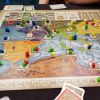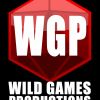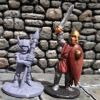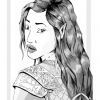Fringe Review: Mythic from ZDL's blog
Mythic is, to quote the game's introduction, "a universal, improvisational role-playing game". Designed by Tana Pigeon, a name you've likely never heard of (though you should have, because she makes some nifty stuff!), it is far more than what that unassuming little description says. This review is all about teasing out exactly what Mythic actually is.
Word Mill Publishing
Word Mill Publishing is the name of a small publishing company run by Tana Pigeon. It's first product (that I'm aware of) was Mythic itself, published first in 2003 and then again in 2006 (I'm unclear as to the circumstances for the two copyright dates, but I suspect one was individual publishing, the second under the Word Mill name). In rapid succession more games were published. Going with just the ones I own there's the Mythic Game Master Emulator (2006), Mythic Variations (2007), the Creature Crafter (2009), World vs. Hero (2010, by John Fiore), and the Location Crafter (2014). Other publications I don't (yet!) have include Mythic Variations II (2017), the Adventure Crafter (2019), and the Mythic Game Master Emulator Deck (2019).
(One of those above games will probably wind up in my Fringe Review series at some point in the future.)
All of these supplements and games have intriguing facets to them that keep me buying more. (If I didn't have the massive problems getting payments out of China I'd already own the three I don't currently have!) This intrigue, however, began with the very first book.
Mythic
As I said in the opening paragraph, Mythic is so much more than what its unassuming self-description says it is. In fact Mythic is several things:
1. It is a standalone, narrative-oriented, free-form, preparation-optional traditional GM+players role-playing game.
2. It is a standalone, narrative-oriented, free-form, GM-free role-playing game.
3. It is a cap system which can sit on top of other RPG rules to turn them into preparational-optional/GM-free role-playing games.
4. It is a standalone, narrative-oriented, free-form solo role-playing game.
5. It is a cap system which can sit on top of other RPG rules to turn them into solo role-playing games.
And, in general, it actually manages to pull off all of these with reasonable competency!
So let's look at these various uses and see how it pulls all this off!
Components
Mythic comes as a 146-page PDF (a printed book is also an option). The cover is garish and red and, in physical form on a shelf, would certainly stand out. Since it is not sold, to my knowledge, in brick and mortar stores I'm not sure why something so eye-catching is needed.
Layout inside the book is competent. Chapter headings get a red boundary (matching the cover colour) around the upper half to make them stand out. Too, the chapter titles are in an an eye-catching font that remains readable. (I wouldn't want to read a large block of text in it, but for titles it's actually pretty neat!) The table of contents is a single page that just lists chapters and page numbers, not breaking it down further. There is a single-page index in 4 columns with smaller type than the main body text. I threw a couple of things I'd read before that I might want to find again later (like "The I Dunno Rule") and, to my amazement, I found things. The index isn't master-class, but it does appear to be useful.
The art is …
Ugh. The art. Here's where I hate this thing in our industry of people thinking that you absolutely must have art or the game is terrible.
Don't get me wrong. I like art, even in my game books. But the art has to be somehow in service of the rules text, not just existing alongside it. Big professionally-produced games can hire artists to make relevant art. Very dedicated searchers of clip art can supply the same. Too often, however, art is just randomly slapped into the book without regard to surrounding text, or any kind of theme in the feel, and this art, in my opinion, can actually detract from a game.
The art in Mythic is of this latter sort. At its best there's some nice moody grayscale art. At its cringiest there's grotesquely distorted, "wrong"-seeming garishly coloured art that would make pretentious indy comic books sit up and say "Whoa, you might want to turn that down a notch or ten". The rest is black & white, cartoonish line art that isn't good and isn't bad. It's just there.
And none of the art is in service in any way, shape, or form to the text around it. To be fair, for a generic game this can be difficult, but the answer to that is to work harder at matching art to text, or ditch the art.
I really hate the art choices, I guess I'm saying.
Thankfully the rest of the book has me covered!
Standalone Mythic
Make no mistake: Mythic is a complete role-playing game. Its game mechanisms cover everything you need for play: character generation, action resolution, character advancement, and adventure/campaign management. (It may not be to your tastes as a complete role-playing game, but that is an entirely different issue.) There are two flavours of standalone Mythic: with GM or GM-free. And there are two approaches to playing it: freeform or point-based. All of these, however, are essentially mild variations of the same two core concepts and mechanisms: logic and interpretation.
Logic
Picture a normal game—say D&D. Do you roll for every little thing? The characters wake up in the morning: Do you roll to see if they can get out of their beds without spraining their ankle? Do you studiously do reaction checks on every NPC they interact with? Do you roll to check if they choke to death on a fish bone from their morning kipper? No, of course you don't! (I'm doing the courtesy of assuming you're not crazy. Work with me here!) What Mythic does is take this one step further. Usually you use the same kind of reasoning you'd use in the situations I've described for the D&D game to decide what happens next: you consider what's already happened, you apply any new twists and information that may have popped up, and from this you decide what the most logical outcome will be.
This isn't to say that you just do writing exercises or improv theatre drills, however. Not at all. There is a "Fate Chart" that you use for important outcomes which can lead to things going in several directions. The general approach is whatever is the most logical outcome is what is expected to happen, but the Fate Chart allows (and indeed, as the game progresses, often causes) the unexpected to happen. "Logic" is the baseline from which the unexpected twists of fate and adventure grow.
Interpretation
Logic drives the baseline, but the key differentiation of actions come from the asking and answering of simple yes/no questions. "Is there are guard behind that door?" "Can I find a key to the wardrobe?" "Do I fool the matron with my disguise?" The answers to these questions, although "yes" or "no" (as well as, effectively "HELL yeah!" and "Are you joking!?"), must be interpreted (using logic once again), however, to make them fit.
Improvisation
Improvisation is key to making logic and interpretation work. It is the single most vital skill in playing the game. Logic says what should happen next. Interpretation tells you what actually happens next when questions are asked. Improvisation is key to tying it all together. It acts as the axis around which logic and interpretation spin, driving the game's engine.
A simple example: "Is there a guard behind that door?" (Result: HELL yeah!) "There is not only a guard, there is a whole squad of them." This is chosen improvisationally because in the past there were signs of a large number of soldiers. Logically the "very yes" response implies that there's more than just one. Other answers could be "There is a guard, but it's the captain." Maybe even "There is a guard, but it's a dragon" if events up to this point in the campaign support that possibility.
Game Mechanics
Everything in Mythic is defined in terms of "details" and "ranks". Details are just important aspects of a character or object: Intuition for a character, Complexity for a computer program, Weight for a rock, Hardness for a gem. Every detail is rated in terms of a rank in everyday language (a concept players of FUDGE or FATE will be familiar with in a ladder from lowest to highest rating of Miniscule, Weak, Low, Below Average, Average, Above Average, High, Exceptional, Incredible, Awesome, Superhuman. Values outside of this ladder can exist two, but are just numbered: Miniscule 2, Miniscule 3, Superhuman 2, Superhuman 5, etc.
Ranks are a subjective measure of potency, so to use them, you have to know … relative to what? If a rank is "average" what is it an average of? In this game intrinsic details (like character attributes) are measured in terms of the "average person". Skills, abilities, and powers are relative to the average practitioner of said skill, ability, or power. So a rating of "average" in stonemasonry is the skill of an average STONEMASON, not of an average person. The rule of thumb is that a "professional" in a non-instrinsic detail would be "average" in rank. Real-world relationships between these word-based ratings and actual numbers, where needed, are created by establishing "benchmarks" where you'd say something like "an average strength person can bench 50kg with ease".
(This is where "logic" enters the picture….)
In the book, at this point, you're started into character generation, with these concepts being required to understand what you're generating. In this review I will postpone character generation to continue with the game mechanics. Specifically I will talk about the Fate Chart which is the beating heart of the game.
All action in Mythic that is not merely narrated is resolved by asking a yes/no question. Does the car start on time? Can I light my lighter on the first try? Are there guards in the warehouse? Does my shot kill the bad guy? Can I persuade the maiden fair for a favour in the tournament? Upon the question being asked, the GM (or in a GM-free game the players in aggregate) decide on how likely the outcome is going to be. The acting rank governing the action (say the seduction skill, or the character's strength) is compared against the established difficulty and this is compared on a chart to get three numbers. For a concrete example if someone with "Awesome" strength is trying to open a door of Above Average resistance, we get the numbers 16/85/97. Rolling d% between 1-16 is an "exceptional yes", 17-85 is "yes", 86-96 is "no" and 97-100 is "exceptional no". Thus 85% of the time the character will succeed (16% being even more favourable than a simple "yes") while 15% of the time the character will fail (with 4% of the time being worse than a simple "no"). Bonuses and penalties in this game operate by column and row shifts on the Fate Chart. A -1 shift of an Average rank, for example, would take it to Below Average. A +2 shift from Incredible takes it to Superhuman. The percentile dice aren't modified, just the row or column of the table is.
This simple mechanism is literally the core of everything in the game. There are some little twists here and there. For example for things that don't involve invoking details on characters or objects ("are there guards in the next room") you figure the odds and compare this to the current "chaos factor"--a mechanism that ratchets up tension in the game as the scenario progresses--and get your answer this way. These same kinds of "odds questions" are used in GM-free play to answer questions about the environment: "Has there been recent activity from the Yellow Turbans?" "Is there a staircase leading up from the foyer?" It is this way that a group of players can, by applying logic and improvisation, interpret the results of yes/no questions to build a world and an adventure. Naturally it takes some finesse to get the right balance of questions and interpretations to get a good feel. The rules provide guidelines for all this but none of this will satisfy a hardcore rules-player. This is not a game for that kind of operation. (At least not in standalone mode. This is called "foreshadowing"...)
Where the rules get a little more fixed, however, is, naturally, combat. While more free-wheeling than most games, it still has tighter rules here than in the rest of the game. In place of combat rounds and initiative rolls and to-hit rolls and damage rolls, however, it has a set of typical questions and answers. Questions like "can I attack now?" or "does she go before me?" are the replacement for initiative rolls, for example. Then maybe the next question, is "does my shot hit it?". Followed by "is it damaged?". This is repeated at need (which implies that unlike most games it is possible to get long strings of attacks unanswered by the enemy if the "can I attack?" questions roll in your favour!). It all sounds very alien, and this is with good reason: it is. But it works very well for most kinds of combats.
Character Generation
As mentioned above there are two kinds of characters: freeform and point-based. They're both simple enough, though obviously free-form characters are easier.
Freeform Characters
Step 1: Write a character summary in the form of a descriptive paragraph to give a brief impression of what your character is about. Think of it as the elevator pitch for your character
Step 2: Set the seven basic attributes (core details that all characters have): Strength, Agility, Reflex, IQ, Intuition, Willpower, Toughness. These are just details, set to ranks, and are otherwise in no way privileged in the game system beyond being mandatory for all characters to have ratings in. It is up to you, your GM (if present) and your fellow players to police whether these attributes match your summary.
Step 3: Set your abilities. These are roughly analogous to skills in most games, though they can also be powers, supernatural abilities, spells, etc. Since a freeform character is considered a kind of "work in progress" it's possible that in play an ability will come up that fits the summary but isn't on the sheet. With GM/other player approval it can be added in play, on the fly.
Step 4: Set your strengths and weaknesses. These give you rank shifts (the very ones mentioned above, hence my talking about the Fate Chart before character generation...) to abilities and/or attributes in specific circumstances. For example "quick draw" might be a strength that gives you a +2 rank shift for any situation involving drawing a gun and firing before an opponent. "Mechanically declined" might be a weakness that gives you a -1 rank shift for any circumstance involving the operation or repair of mechanical equipment. As with abilities, it may happen that a strength or a weakness arises in play, but it should be far rarer than abilities.
Step 5: Notes are used to sketch out more details. A pirate may have a ship and crew, for example. Or a knight may have a faithful squire and a set of armour. One special note that is carefully paid attention to is the favour points a character has. Favour points are directly applied at will (to a maximum of 25 at a time) AFTER the dice are rolled to move the value in a more favourable direction. Characters start with 50 of these and get them awarded for making progress on "threads" (adventure story lines).
Point-based Characters
These are made in a similar way to freeform. The summary, attributes, abilities, strengths & weaknesses, and notes are all there. What differs is that attributes and abilities have both a number of points available to buy them with, and a maximum rank purchaseable based on the style of campaign setting. "Real world" characters will have 30 attribute points, 10 ability points with a maximum rank of Exceptional, for example, while these may be 60/35/Superhuman for a pulp action game. Strengths are paid for either from left-over attribute/ability points or by taking weaknesses. Aside from adding a bit of arithmetic to the proceedings, there is little difference in characters made this way over freeform characters.
(Point-based characters may have undefined-at-generation abilities, strengths, and weaknesses as well, though these should not be as common and will likely be vetoed more often.)
The Rest of the Game
The rest of the game covers how to run a game of Mythic and here there is a detailed and very complete event system provided to help drive stories. It involves the creation of story threads, events that move threads along, and events that conclude stories. Time is divided into scenes--Mythic is unapologetically cinematic over simulationist--which can be of varying kinds including altered and interrupting scenes. While it is not difficult it is rather large and all-encompassing and will probably require a few reads before you get the hang of it. In the author's favour there are MANY examples, small and large both, that cover everything from how to record decisions to how to build worlds.
And that covers standalone Mythic. But that's only part of the game. Remember the list? Mythic is also usable as a cap system and a solo system. How does that work?
Solo Mythic
Let's first handle solo play. This is easy as pie. You're the GM and the player, and you use the GM emulator for building the world, running events, building and following story threads, and running combat. It's like GM-free with the added twist there is only one player. That's it. That's the whole secret. Nothing trickier is involved.
Cap System
So how do you use it as a cap system? That's easy. When it comes to resolving things that your favoured game resolves, use your favoured game. Mythic is then used only for its GM emulator stuff to do no-prep (and optionally no-GM) gaming. Use Mythic to deal with random events. To start and move along story lines. To build up setting information with questions. When it comes to combat or persuasion or such things which your favoured game does better in your opinion, just ... use it.
Evaluation
Going back to the intended use, is Mythic actually "a universal, improvisational role-playing game"?
The answer is … uh, let me check the Fate Chart. Now Tana Pigeon is an Exceptional designer and the task is Awesomely hard. Cross-indexing that's 7/35/88 … rolling, oh wait. That's a -2 shift for the sheer insanity of attempting the task in the first place, so it's actually 3/15/84 … And …
Yes.
But only yes. Not exceptional yes.
Mythic is a very good system that's amazingly clean at its core. It does provide everything it sets out to do. It is a complete RPG, both freeform and point-based being viable options. It excels at supporting low/no-prep GMing and even no-GM play. It's even quite good for solo play. Where it fumbles the ball a bit, in my opinion, is in its use as a cap system. It gives four pages of guidance there (predictably and understandably D&D-focused) much of it being very hand-wavy and closing off with what reads like "meh, if you don't like the guidance here, do it yourself".
Which is so very bizarre because this is the single best way to wean people into using Mythic! A cap system gateway would make people, I think, look more closely at Mythic and possibly then start incorporating more and more of the game beyond the GM emulator stuff. Later publications by Word Mill press do, in fact, exactly this, so perhaps this is something Tana Pigeon has caught on to, but it was a surprise to me that the first book glossed over this so quickly.
But this little misstep aside, Mythic is a very good addition to the toolbox of any GM. And it is one of the few games I've found that really does support solo play in a satisfying way (which is the primary use I put it to).
Word Mill Publishing
Word Mill Publishing is the name of a small publishing company run by Tana Pigeon. It's first product (that I'm aware of) was Mythic itself, published first in 2003 and then again in 2006 (I'm unclear as to the circumstances for the two copyright dates, but I suspect one was individual publishing, the second under the Word Mill name). In rapid succession more games were published. Going with just the ones I own there's the Mythic Game Master Emulator (2006), Mythic Variations (2007), the Creature Crafter (2009), World vs. Hero (2010, by John Fiore), and the Location Crafter (2014). Other publications I don't (yet!) have include Mythic Variations II (2017), the Adventure Crafter (2019), and the Mythic Game Master Emulator Deck (2019).
(One of those above games will probably wind up in my Fringe Review series at some point in the future.)
All of these supplements and games have intriguing facets to them that keep me buying more. (If I didn't have the massive problems getting payments out of China I'd already own the three I don't currently have!) This intrigue, however, began with the very first book.
Mythic
As I said in the opening paragraph, Mythic is so much more than what its unassuming self-description says it is. In fact Mythic is several things:
1. It is a standalone, narrative-oriented, free-form, preparation-optional traditional GM+players role-playing game.
2. It is a standalone, narrative-oriented, free-form, GM-free role-playing game.
3. It is a cap system which can sit on top of other RPG rules to turn them into preparational-optional/GM-free role-playing games.
4. It is a standalone, narrative-oriented, free-form solo role-playing game.
5. It is a cap system which can sit on top of other RPG rules to turn them into solo role-playing games.
And, in general, it actually manages to pull off all of these with reasonable competency!
So let's look at these various uses and see how it pulls all this off!
Components
Mythic comes as a 146-page PDF (a printed book is also an option). The cover is garish and red and, in physical form on a shelf, would certainly stand out. Since it is not sold, to my knowledge, in brick and mortar stores I'm not sure why something so eye-catching is needed.
Layout inside the book is competent. Chapter headings get a red boundary (matching the cover colour) around the upper half to make them stand out. Too, the chapter titles are in an an eye-catching font that remains readable. (I wouldn't want to read a large block of text in it, but for titles it's actually pretty neat!) The table of contents is a single page that just lists chapters and page numbers, not breaking it down further. There is a single-page index in 4 columns with smaller type than the main body text. I threw a couple of things I'd read before that I might want to find again later (like "The I Dunno Rule") and, to my amazement, I found things. The index isn't master-class, but it does appear to be useful.
The art is …
Ugh. The art. Here's where I hate this thing in our industry of people thinking that you absolutely must have art or the game is terrible.
Don't get me wrong. I like art, even in my game books. But the art has to be somehow in service of the rules text, not just existing alongside it. Big professionally-produced games can hire artists to make relevant art. Very dedicated searchers of clip art can supply the same. Too often, however, art is just randomly slapped into the book without regard to surrounding text, or any kind of theme in the feel, and this art, in my opinion, can actually detract from a game.
The art in Mythic is of this latter sort. At its best there's some nice moody grayscale art. At its cringiest there's grotesquely distorted, "wrong"-seeming garishly coloured art that would make pretentious indy comic books sit up and say "Whoa, you might want to turn that down a notch or ten". The rest is black & white, cartoonish line art that isn't good and isn't bad. It's just there.
And none of the art is in service in any way, shape, or form to the text around it. To be fair, for a generic game this can be difficult, but the answer to that is to work harder at matching art to text, or ditch the art.
I really hate the art choices, I guess I'm saying.
Thankfully the rest of the book has me covered!
Standalone Mythic
Make no mistake: Mythic is a complete role-playing game. Its game mechanisms cover everything you need for play: character generation, action resolution, character advancement, and adventure/campaign management. (It may not be to your tastes as a complete role-playing game, but that is an entirely different issue.) There are two flavours of standalone Mythic: with GM or GM-free. And there are two approaches to playing it: freeform or point-based. All of these, however, are essentially mild variations of the same two core concepts and mechanisms: logic and interpretation.
Logic
Picture a normal game—say D&D. Do you roll for every little thing? The characters wake up in the morning: Do you roll to see if they can get out of their beds without spraining their ankle? Do you studiously do reaction checks on every NPC they interact with? Do you roll to check if they choke to death on a fish bone from their morning kipper? No, of course you don't! (I'm doing the courtesy of assuming you're not crazy. Work with me here!) What Mythic does is take this one step further. Usually you use the same kind of reasoning you'd use in the situations I've described for the D&D game to decide what happens next: you consider what's already happened, you apply any new twists and information that may have popped up, and from this you decide what the most logical outcome will be.
This isn't to say that you just do writing exercises or improv theatre drills, however. Not at all. There is a "Fate Chart" that you use for important outcomes which can lead to things going in several directions. The general approach is whatever is the most logical outcome is what is expected to happen, but the Fate Chart allows (and indeed, as the game progresses, often causes) the unexpected to happen. "Logic" is the baseline from which the unexpected twists of fate and adventure grow.
Interpretation
Logic drives the baseline, but the key differentiation of actions come from the asking and answering of simple yes/no questions. "Is there are guard behind that door?" "Can I find a key to the wardrobe?" "Do I fool the matron with my disguise?" The answers to these questions, although "yes" or "no" (as well as, effectively "HELL yeah!" and "Are you joking!?"), must be interpreted (using logic once again), however, to make them fit.
Improvisation
Improvisation is key to making logic and interpretation work. It is the single most vital skill in playing the game. Logic says what should happen next. Interpretation tells you what actually happens next when questions are asked. Improvisation is key to tying it all together. It acts as the axis around which logic and interpretation spin, driving the game's engine.
A simple example: "Is there a guard behind that door?" (Result: HELL yeah!) "There is not only a guard, there is a whole squad of them." This is chosen improvisationally because in the past there were signs of a large number of soldiers. Logically the "very yes" response implies that there's more than just one. Other answers could be "There is a guard, but it's the captain." Maybe even "There is a guard, but it's a dragon" if events up to this point in the campaign support that possibility.
Game Mechanics
Everything in Mythic is defined in terms of "details" and "ranks". Details are just important aspects of a character or object: Intuition for a character, Complexity for a computer program, Weight for a rock, Hardness for a gem. Every detail is rated in terms of a rank in everyday language (a concept players of FUDGE or FATE will be familiar with in a ladder from lowest to highest rating of Miniscule, Weak, Low, Below Average, Average, Above Average, High, Exceptional, Incredible, Awesome, Superhuman. Values outside of this ladder can exist two, but are just numbered: Miniscule 2, Miniscule 3, Superhuman 2, Superhuman 5, etc.
Ranks are a subjective measure of potency, so to use them, you have to know … relative to what? If a rank is "average" what is it an average of? In this game intrinsic details (like character attributes) are measured in terms of the "average person". Skills, abilities, and powers are relative to the average practitioner of said skill, ability, or power. So a rating of "average" in stonemasonry is the skill of an average STONEMASON, not of an average person. The rule of thumb is that a "professional" in a non-instrinsic detail would be "average" in rank. Real-world relationships between these word-based ratings and actual numbers, where needed, are created by establishing "benchmarks" where you'd say something like "an average strength person can bench 50kg with ease".
(This is where "logic" enters the picture….)
In the book, at this point, you're started into character generation, with these concepts being required to understand what you're generating. In this review I will postpone character generation to continue with the game mechanics. Specifically I will talk about the Fate Chart which is the beating heart of the game.
All action in Mythic that is not merely narrated is resolved by asking a yes/no question. Does the car start on time? Can I light my lighter on the first try? Are there guards in the warehouse? Does my shot kill the bad guy? Can I persuade the maiden fair for a favour in the tournament? Upon the question being asked, the GM (or in a GM-free game the players in aggregate) decide on how likely the outcome is going to be. The acting rank governing the action (say the seduction skill, or the character's strength) is compared against the established difficulty and this is compared on a chart to get three numbers. For a concrete example if someone with "Awesome" strength is trying to open a door of Above Average resistance, we get the numbers 16/85/97. Rolling d% between 1-16 is an "exceptional yes", 17-85 is "yes", 86-96 is "no" and 97-100 is "exceptional no". Thus 85% of the time the character will succeed (16% being even more favourable than a simple "yes") while 15% of the time the character will fail (with 4% of the time being worse than a simple "no"). Bonuses and penalties in this game operate by column and row shifts on the Fate Chart. A -1 shift of an Average rank, for example, would take it to Below Average. A +2 shift from Incredible takes it to Superhuman. The percentile dice aren't modified, just the row or column of the table is.
This simple mechanism is literally the core of everything in the game. There are some little twists here and there. For example for things that don't involve invoking details on characters or objects ("are there guards in the next room") you figure the odds and compare this to the current "chaos factor"--a mechanism that ratchets up tension in the game as the scenario progresses--and get your answer this way. These same kinds of "odds questions" are used in GM-free play to answer questions about the environment: "Has there been recent activity from the Yellow Turbans?" "Is there a staircase leading up from the foyer?" It is this way that a group of players can, by applying logic and improvisation, interpret the results of yes/no questions to build a world and an adventure. Naturally it takes some finesse to get the right balance of questions and interpretations to get a good feel. The rules provide guidelines for all this but none of this will satisfy a hardcore rules-player. This is not a game for that kind of operation. (At least not in standalone mode. This is called "foreshadowing"...)
Where the rules get a little more fixed, however, is, naturally, combat. While more free-wheeling than most games, it still has tighter rules here than in the rest of the game. In place of combat rounds and initiative rolls and to-hit rolls and damage rolls, however, it has a set of typical questions and answers. Questions like "can I attack now?" or "does she go before me?" are the replacement for initiative rolls, for example. Then maybe the next question, is "does my shot hit it?". Followed by "is it damaged?". This is repeated at need (which implies that unlike most games it is possible to get long strings of attacks unanswered by the enemy if the "can I attack?" questions roll in your favour!). It all sounds very alien, and this is with good reason: it is. But it works very well for most kinds of combats.
Character Generation
As mentioned above there are two kinds of characters: freeform and point-based. They're both simple enough, though obviously free-form characters are easier.
Freeform Characters
Step 1: Write a character summary in the form of a descriptive paragraph to give a brief impression of what your character is about. Think of it as the elevator pitch for your character
Step 2: Set the seven basic attributes (core details that all characters have): Strength, Agility, Reflex, IQ, Intuition, Willpower, Toughness. These are just details, set to ranks, and are otherwise in no way privileged in the game system beyond being mandatory for all characters to have ratings in. It is up to you, your GM (if present) and your fellow players to police whether these attributes match your summary.
Step 3: Set your abilities. These are roughly analogous to skills in most games, though they can also be powers, supernatural abilities, spells, etc. Since a freeform character is considered a kind of "work in progress" it's possible that in play an ability will come up that fits the summary but isn't on the sheet. With GM/other player approval it can be added in play, on the fly.
Step 4: Set your strengths and weaknesses. These give you rank shifts (the very ones mentioned above, hence my talking about the Fate Chart before character generation...) to abilities and/or attributes in specific circumstances. For example "quick draw" might be a strength that gives you a +2 rank shift for any situation involving drawing a gun and firing before an opponent. "Mechanically declined" might be a weakness that gives you a -1 rank shift for any circumstance involving the operation or repair of mechanical equipment. As with abilities, it may happen that a strength or a weakness arises in play, but it should be far rarer than abilities.
Step 5: Notes are used to sketch out more details. A pirate may have a ship and crew, for example. Or a knight may have a faithful squire and a set of armour. One special note that is carefully paid attention to is the favour points a character has. Favour points are directly applied at will (to a maximum of 25 at a time) AFTER the dice are rolled to move the value in a more favourable direction. Characters start with 50 of these and get them awarded for making progress on "threads" (adventure story lines).
Point-based Characters
These are made in a similar way to freeform. The summary, attributes, abilities, strengths & weaknesses, and notes are all there. What differs is that attributes and abilities have both a number of points available to buy them with, and a maximum rank purchaseable based on the style of campaign setting. "Real world" characters will have 30 attribute points, 10 ability points with a maximum rank of Exceptional, for example, while these may be 60/35/Superhuman for a pulp action game. Strengths are paid for either from left-over attribute/ability points or by taking weaknesses. Aside from adding a bit of arithmetic to the proceedings, there is little difference in characters made this way over freeform characters.
(Point-based characters may have undefined-at-generation abilities, strengths, and weaknesses as well, though these should not be as common and will likely be vetoed more often.)
The Rest of the Game
The rest of the game covers how to run a game of Mythic and here there is a detailed and very complete event system provided to help drive stories. It involves the creation of story threads, events that move threads along, and events that conclude stories. Time is divided into scenes--Mythic is unapologetically cinematic over simulationist--which can be of varying kinds including altered and interrupting scenes. While it is not difficult it is rather large and all-encompassing and will probably require a few reads before you get the hang of it. In the author's favour there are MANY examples, small and large both, that cover everything from how to record decisions to how to build worlds.
And that covers standalone Mythic. But that's only part of the game. Remember the list? Mythic is also usable as a cap system and a solo system. How does that work?
Solo Mythic
Let's first handle solo play. This is easy as pie. You're the GM and the player, and you use the GM emulator for building the world, running events, building and following story threads, and running combat. It's like GM-free with the added twist there is only one player. That's it. That's the whole secret. Nothing trickier is involved.
Cap System
So how do you use it as a cap system? That's easy. When it comes to resolving things that your favoured game resolves, use your favoured game. Mythic is then used only for its GM emulator stuff to do no-prep (and optionally no-GM) gaming. Use Mythic to deal with random events. To start and move along story lines. To build up setting information with questions. When it comes to combat or persuasion or such things which your favoured game does better in your opinion, just ... use it.
Evaluation
Going back to the intended use, is Mythic actually "a universal, improvisational role-playing game"?
The answer is … uh, let me check the Fate Chart. Now Tana Pigeon is an Exceptional designer and the task is Awesomely hard. Cross-indexing that's 7/35/88 … rolling, oh wait. That's a -2 shift for the sheer insanity of attempting the task in the first place, so it's actually 3/15/84 … And …
Yes.
But only yes. Not exceptional yes.
Mythic is a very good system that's amazingly clean at its core. It does provide everything it sets out to do. It is a complete RPG, both freeform and point-based being viable options. It excels at supporting low/no-prep GMing and even no-GM play. It's even quite good for solo play. Where it fumbles the ball a bit, in my opinion, is in its use as a cap system. It gives four pages of guidance there (predictably and understandably D&D-focused) much of it being very hand-wavy and closing off with what reads like "meh, if you don't like the guidance here, do it yourself".
Which is so very bizarre because this is the single best way to wean people into using Mythic! A cap system gateway would make people, I think, look more closely at Mythic and possibly then start incorporating more and more of the game beyond the GM emulator stuff. Later publications by Word Mill press do, in fact, exactly this, so perhaps this is something Tana Pigeon has caught on to, but it was a surprise to me that the first book glossed over this so quickly.
But this little misstep aside, Mythic is a very good addition to the toolbox of any GM. And it is one of the few games I've found that really does support solo play in a satisfying way (which is the primary use I put it to).
















The Wall